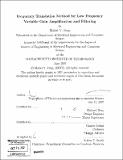Frequency translation method for low frequency variable gain amplification and filtering
Author(s)
Feng, Mabel Y
DownloadFull printable version (7.494Mb)
Other Contributors
Massachusetts Institute of Technology. Dept. of Electrical Engineering and Computer Science.
Advisor
Richard Reay and Charles Sodini.
Terms of use
Metadata
Show full item recordAbstract
This thesis discusses an innovative solution to an industry challenge. A frequency translation method is designed to shift low frequency signals to intermediate frequencies in order to utilize higher-frequency components. This solution, appropriate for applications involving 1-10MHz signals, can provide continuously variable gain and filtering at little cost in dynamic performance. The working system converts the low frequency signals up to the 70MHz band to achieve up to 28dB attenuation and 60-86MHz variable filtering. A Single Side Band system has a Signal-to-Noise Ratio (SNR) of 71dB with a 73dB SNR Analog-to-Digital Converter (ADC), 44 dB Output Third-Order Intercept Point (OIP3), and a Noise Figure (NF) of 14dB. Ultrasound and other applications in the 1-10MHz range benefit greatly from this upconversion scheme.
Description
Thesis (M. Eng.)--Massachusetts Institute of Technology, Dept. of Electrical Engineering and Computer Science, 2007. Includes bibliographical references (leaves 75-78).
Date issued
2007Department
Massachusetts Institute of Technology. Department of Electrical Engineering and Computer SciencePublisher
Massachusetts Institute of Technology
Keywords
Electrical Engineering and Computer Science.